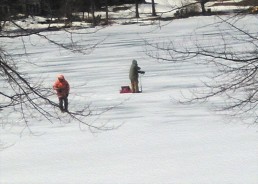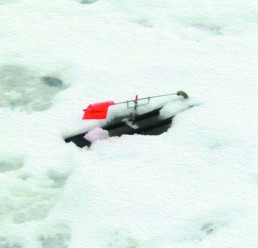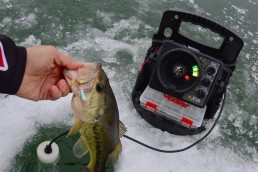Understanding Impact of Barometric Pressure on Ice Fishing
SHARE THIS POST
It is well documented that barometric pressure is instrumental in having an affect on fish within the open waters of lakes and ponds. What is less known is the affect of barometric pressure on waters frozen over from the winter weather.
Even though a body of water is capped with ice, the fish below are not immune to the effects of barometric pressure. Having knowledge of this phenomenon is instrumental in the ice fishing angler’s adjustment strategies for ensuring success.
Barometric pressure is scientific jargon many don’t really understand, but it is not as confusing as it is perceived. Steve Caparizzo, chief meteorologist at an ABC news affiliate, explained the concept of barometric pressure in simple terms:
“The atmosphere has weight and barometric pressure is a measurement of the weight of the atmosphere pressing down toward the earth’s surface,” Caparizzo says. “This barometric pressure will change when storm systems arrive and depart. Envision a large hand in the higher reaches of the atmosphere. When this large hand presses down on the atmosphere at the departure of a storm system, a high pressure is generated. As a storm system approaches, envision the large hand in the atmosphere reducing its push down on the atmosphere. This is low pressure.
“A high pressure of the atmosphere will press down upon the surface of water, further compacting the water molecules that are already much denser than the air above, and this can make fish uncomfortable. When a fish is uncomfortable, that fish is far less likely to have a desire to feed.”
The conditions have an impact on fish’s comfort levels in feeding habits. If they are not feeding, they will be less inclined to bite an angler’s offerings.
Caparizzo is a hardcore ice fisherman and convinced that fish can still sense pressure changes underneath the ice. Many other experts believe that this compacting of the water molecules with high pressure has a definite impact on applying pressure to the bladder of the fish, which is linked to the fish feeling “uncomfortable.” A low pressure system though will reduce the pressure of the atmosphere on the surface of the ice, easing the pressure of the water molecules and subsequently lessening pressure on the fish’s bladder, making their feeding patterns active.
Are you enjoying this post?
You can be among the first to get the latest info on where to go, what to use and how to use it!
Changing pressure systems and fluctuating barometric readings over an iced body of water can cause fish to move within the water to more comfortable areas. When a low approaches and the barometric pressure begins falling, fish will be more inclined to be higher in the less pressured water depths, and may be just below the surface of the ice.
As the storm front begins to weaken and pass by, the high pressure begins to increase, further compacting the water molecules, especially in the denser, deeper water. The fish will become uncomfortable and retreat from these deeper waters. These fish will need a period of time to acclimate to the uncomfortable pressure change, and may not show any desire to feed for a up to a full day, or perhaps longer. Once the fish have gotten more accustomed to the high pressure, they will resume a more normal feeding behavior.
Barometric pressure is not the only factor. Other conditions, including ice depth and clarity can have impacts on the fish.
The penetration of sunlight through the ice is an important variable. Thick ice and snow cover can reduce oxygen content within the water, especially in deeper depths, as the fish will not tolerate an oxygen-depleted zone.
The metabolism of the fish is another factor, as it dramatically slows within colder water, meaning it takes longer for a fish to digest its food. Fish in the cold water are not expending as much energy too, so they may be less inclined to eat, regardless of a favorable change in the pressure.
It is difficult to disregard the importance of changing barometric pressure for fish within an iced-over lake. Understanding pressure changes will certainly help increase the ice fishing angler’s catch ratio.
MWO
SHARE THIS POST
Did you enjoy this post?
You can be among the first to get the latest info on where to go, what to use and how to use it!
John Murray
John Murray has a passion for the outdoors. A former professional fly tyer and fishing shop owner for more than a decade, John is a member of the NYS Outdoor Writers Association and is determined to share an acquired lifetime of knowledge to help everyone become proficient hunters and anglers.




